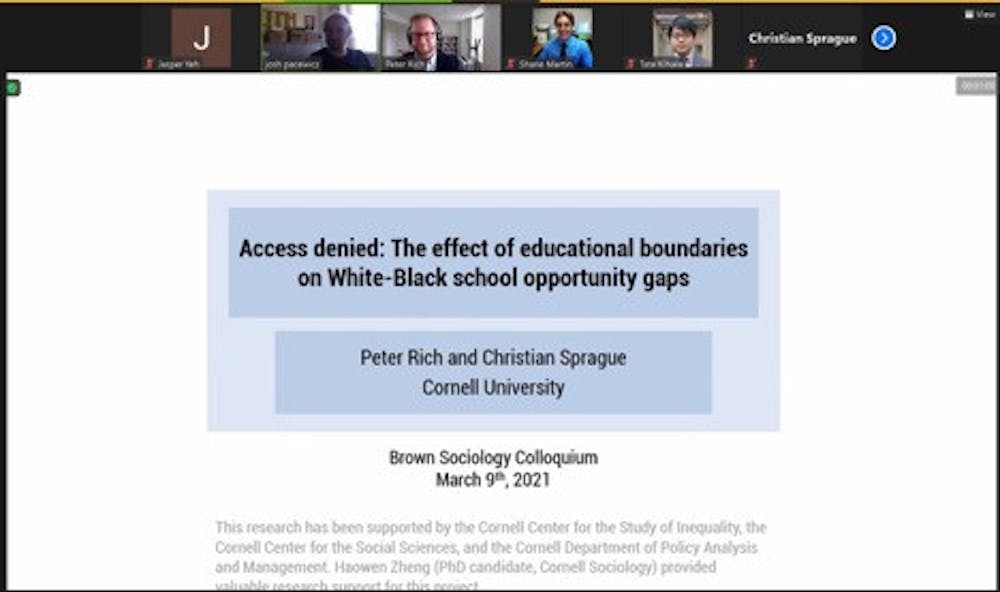Nearly 70 years ago, the Supreme Court case Brown v. Board of Education of Topeka deemed racial segregation in schools unconstitutional. Yet, gaps persist in access to quality education among racial groups, as highlighted by Associate Professor of Sociology and Policy Analysis and Management at Cornell Peter Rich at a panel Tuesday, where he discussed his most recent research project.
The panel was hosted by the Department of Sociology and moderated by Josh Pacewicz, associate professor of sociology at the University. Participants included graduate students working with Rich on the project as well as other University faculty members.
Rich’s work focuses on inequality through studying topics such as school segregation and disparities in test scores among different demographics.
The study presented by Rich examined the effects of school district lines and student location of residence on academic achievement and was co-authored by Christian Sprague, a Ph.D. student at Cornell.
These two factors can create disparities in academic achievement. For instance, numerous students are forced to enroll in schools far away from their home even when there are closer options, simply due to how district lines are drawn, according to Rich. “Many, many children live close to (school district) boundaries they cannot cross.”
In terms of access to high-achieving schools, Rich found that school district lines increased the gap between white and Black populations by “17 percent more than residential location alone.”
If school choice were not restricted by superimposed school district lines, there would be a smaller racial disparity in academic results, Rich said. He added that the very nature of assigning a student a school based on their home address is problematic.
“By tying residence to school access, what we're doing is effectively tying opportunity ... to family background,” he said.
Rich sought to answer two questions in his study: “How does access to school quality change when removing educational boundaries?” and “What effect did boundaries have on white-Black gaps in access to educational opportunity?”
To examine the effects of district boundaries on academic outcomes, Rich and his team first created a city map labeled with school achievement data. They then generated a hypothetical map without school district boundaries to examine the potential impact on access to high-achieving schools.
To illuminate this method, Rich presented a case study of the Oakland Piedmont Unified School District, a wealthy region in the San Francisco Bay Area.
Piedmont serves as an example of what Rich calls “fiefdoms of privilege” enclosed by educational boundaries. These boundaries “are unmeritocratic in that they link access to opportunity to family resources,” Rich said. “Their removal would be radically redistributive.”
By studying a hypothetical “boundaryless” Piedmont, Rich found that students in the northern region of Oakland, who were originally restricted to lower-achieving schools in their own district, had greater access to high-achieving schools after boundaries were removed. Similar results were found when he ran the hypothetical model on Providence.
In the final part of the panel, Rich elaborated on the implications his project has on racial disparities, focusing on gaps between Black and white populations.
Currently, there are dramatic disparities between educational access in these populations. “What we're seeing here is an overrepresentation of Black children in areas where access to schools is below the median,” Rich said.
Using the same hypothetical model, Rich saw that after eliminating school district boundaries, the “Black disadvantage is recovered” and the “white advantage ... is relinquished.”
In response to a question from an audience member, Rich noted that the experiences of Latinx populations are largely similar to those of the Black population. On the other hand, while data shows Asians have overall better access to quality schools compared to people who are white, larger variations in Asian experiences contribute to greater disparities within the Asian population itself.
Finally, Rich commented on the complexity of racial disparities in education, acknowledging the “many dimensions of inequality and dimensions of school quality we can consider.”
Discussing the implications of his research study, Rich cited the intense backlash St. Louis encountered when it attempted to redraw district lines to increase educational access.
The cost of policymakers being unwilling to take action for fear of backlash “is currently borne by marginalized populations,” he said. “Just because there would be backlash doesn't mean it is not an important consideration. In fact, that may mean it's a particularly important consideration.”

ADVERTISEMENT




